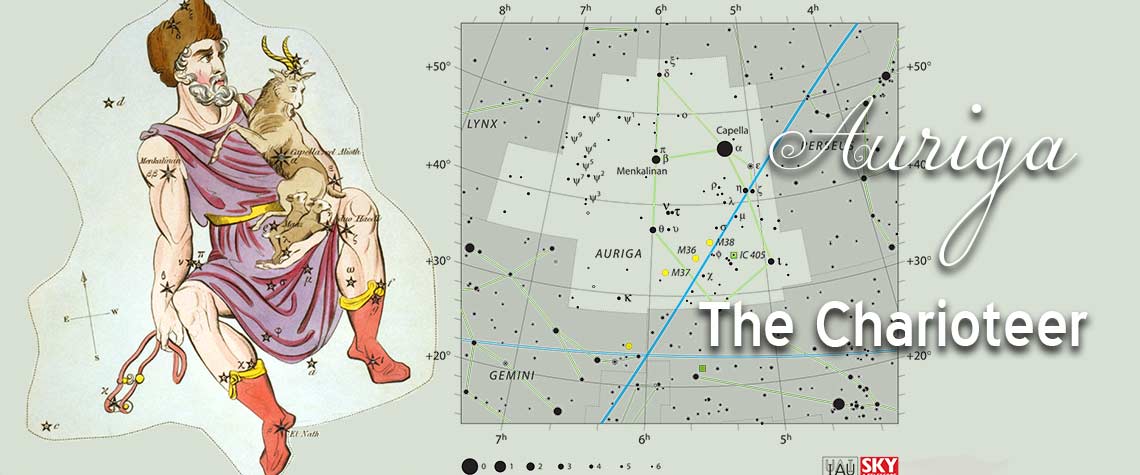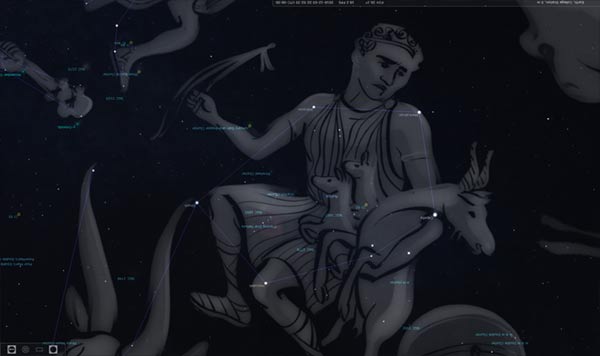Page 2


Eye on the Sky - Auriga
By Tom Campbell
Ancient charioteers (or wagoners) looked after the chariots and horses of their rulers or masters. They also watched over the other livestock. Some star charts depict the constellation of Auriga as a person holding a goat in one hand and a bridle in the other. Others depict the constellation as a giant chariot wheel. The Greek poet Aratus said this of Auriga:
But if it be thy wish to mark the Charioteer
And his stars, and if the fame has come to thee
Of the Goat herself and the Kids, who often
On the darkening deep have seen men storm-tossed,
Thou wilt find him in all his might, leaning forward
At the left hand of the Twins. Over and against him
Wheels the top of Helice's head, but on his left shoulder
Is set the holy Goat, that, as legend tells, gave the breast
To Zeus. Her the interpreters of Zeus call Olenian Goat.
Large she is and bright, but there at the wrist of the
Charioteer faintly gleam the Kids.
The Mythological Story of Auriga
One story that involves a charioteer is that of Myrtilos, the charioteer of the king of Elis. The king had a beautiful daughter, Hippodameia. Many men of the land sought the hand of Hippodameia, but the king did not want her to marry because an oracle had predicted that his son-in-law would cause his death.
The king did not refuse his daughter's suitors outright, but instead required them to compete against him in a chariot race. If the suitor won, he could marry his daughter. If the king won, the suitor would be put to death.
One day, however, Pelops visited the court. Hippodameia fell in love with him and she schemed to save her lover from certain death. She knew that Myrtilos secretly loved her and needing his support, she pretended that she loved him as well.
Hippodameia asked Myrtilos to remove the wheel-pegs from her father's chariot just before Pelops' race was to start. He did so, and the king's chariot collapsed during the race, causing the king to be killed.
This left Hippodameia free to marry Pelops. When Myrtilos persisted in his efforts to love Hippodameia, Pelops pushed him from a rock to the sea, where he died. Pelops then became the master of Olympia and ruler of Arcadia and the area became known as Peloponnesus, which means Island of Pelops. Meanwhile, the gods took pity on loyal Myrtilos and turned him into the constellation of Auriga.
Start Star Hopping
Auriga is a rich area of the sky for both photographic and visual observers. Astrophotographers will love the wide assortment of faint nebulosity in the region, including the Flaming Star and the Tadpoles. Visual observers will love the variety of open clusters that can be enjoyed even in light-polluted skies. This article will concentrate on the visual gems.
Double Stars
Capella (α Aur) is the brightest star in the constellation and the sixth brightest star in the night sky. It is a member of the Hyades moving cluster (many members of which are actually in the constellation of Taurus), and made its closest approach to Earth about 237,000 years ago, when it would have been the brightest star in the night sky with a magnitude of -0.8.
The star has a close companion that can most easily be detected using an interferometer. In 1914, it was discovered that there was a third member and in 1936, it was observed that this third companion was also a binary star. These third (Capella H)and fourth (Capella L) members are visible in amateur telescopes. Look for a reddish star of about 10th magnitude nestled nearby amongst some background stars. Cranking up the magnification on this red dwarf reveals the fourth member.
Another nice double star in Auriga is Mahasim (θ Aur). The primary is a large white star with an abnormally high abundance of silicon and it completes a rotation every 3.6 days (our own Sun takes about 26 days to rotate). The companion is a much smaller and fainter yellow-white star. The color and brightness differences make this an interesting pair visually.
Open Clusters
Facing near the plane of the Milky Way, Auriga is home to several open clusters. One of the brighter ones is Messier 36 (also known as NGC 1960). Visually, there is a line of three bright stars with several fainter stars sprinkled around them. My nephew once described the constellation as a headless snowman, with the line of stars representing the buttons down its chest. It is also known as the Pinwheel Cluster.
Messier 37 could easily be called the constellation's show-stopper. Nicknamed the January Salt-and-Pepper Cluster, This cluster is about 450 million years old and contains approximately 500 stars. Right near the center of the cluster is a bright example of one of the dozen or so red giants found within it.
Messier 38 features a prominent yellow giant as its brightest star with a mass of about 900 Suns. This nebula has been referred to as the Pi In The Sky Cluster due to the pattern formed by its brightest members. Some people, however, say it more closely resembles a starfish.
NGC 1664 Most of the stars in this cluster are the same brightness and appear to some as looking like a kite with a long tail or a miniature version of Scorpius.
NGC 1857 is yet another open cluster. Its three brightest members form a straight line down the middle of the cluster, making it similar in appearance to Messier 36.
Located near M 38, NGC 1907 is a little fainter and farther away. It only contains about 30 stars but appears rich in stars due to its compact size.
The next cluster on our list holds a surprise. NGC 1931 is near M 36, and has been called a miniature Orion Nebula due to a bright emission-reflection nebula surrounding the region. The nebula even contains its own version of the Trapezium cluster!
Our tour of Auriga ends with NGC 2126. This open cluster is shaped like a right triangle, with a very bright star (possibly not a member) at the tip of the right angle.
| Object | Type | Mag(s) | Dist. (ly) | R. A. | Dec. |
|---|---|---|---|---|---|
| Capella (α Aur) | Multiple Star | 0.1, 10.2, 13.7 | 43 | 05h 16.7m | +46° 00' |
| Mahasim (θ Aur) | Double Star | 2.6, 7.2 | 166 | 05h 59.7m | +37° 13' |
| M 36 (NGC 1960) | Open Cluster | 6.0 | 4,340 | 05h 36.3m | +34° 08' |
| M 37 (NGC 2099) | Open Cluster | 6.2 | 4,500 | 05h 52.3m | +32° 33' |
| M 38 (NGC 1912) | Open Cluster | 7.4 | 3,480 | 05h 28.7m | +35° 51' |
| NGC 1664 | Open Cluster | 7.6 | 3,910 | 04h 51.1m | +43° 41' |
| NGC 1857 | Open Cluster | 7.0 | 05h 20.1m | +39° 21' | |
| NGC 1907 | Open Cluster | 8.2 | 4,500 | 05h 28.1m | +35° 19' |
| NGC 1931 | Open Cluster + Nebula | 10.1 | 7,000 | 05h 20.1m | +39° 21' |
| NGC 2126 | Open Cluster | 10.2 | 3,600 | 06h 02.9m | +49° 54' |
Banner image attributions:
Auriga carrying the goat and kids as depicted in Urania's Mirror, a set of constellation cards illustrated by Sidney Hall, London circa 1825 - Sidney Hall [Public domain]
Sky and Telescope Map: IAU and Sky & Telescope magazine (Roger Sinnott & Rick Fienberg) [CC BY 3.0 (https://creativecommons.org/licenses/by/3.0)], via Wikimedia Commons
